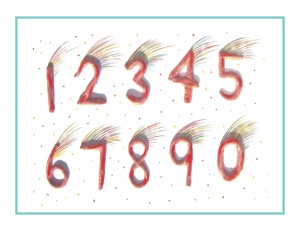Day 1.
For one year, 365 days, this blog will address the Common Core Standards from the perspective of creating an alternate, ambient learning environment for teaching math. Each standard will be given an ambient translation, with suggestions for lessons and activities that match it. The goal will be to address the math standards from Kindergarten on to at least Grade 5 (maybe further). This said, Kindergarten will perhaps be the most challenging, since the need for a truly ambient math is greatest at that level.
Ambient is defined as “existing or present on all sides, an all-encompassing atmosphere.” And ambient music is defined as: “Quiet and relaxing with melodies that repeat many times.” (By the way, the soundtrack for the many hours spent at the computer creating Math By Hand has been taken exclusively from the iTunes Ambient channel.)
Why ambient math? If your math teaching style is ambient, presented in a whole, all-encompassing way, it will be more apt to be absorbed naturally, as languages are by very young children. The 7 – 14 year old child learns best when abstract concepts are cloaked in images, movement, and stories. Because math tends to be the subject most prone to abstraction, it’s most essential for the teacher to be conscious of keeping all lessons and activities real, colorful, and lively.
Math lessons should be quiet and relaxing, with themes that repeat many times. Factoring for instance, could be taught at first in a whimsical, pictorial way, then brought back again and again, progressively more abstractly. This is sometimes called the spiral method, as the same idea is revisited again and again, on higher levels.
I believe that the “back door” or indirect approach is a most effective teaching tool, especially with math. Most children will happily and eagerly take on any task presented in a friendly, warm, and meaningful way. When I taught math to third graders in a Waldorf classroom, they gleefully learned their times tables playing Baseball Math. The correct answer to a pitched problem was always a hit!
The Race to the Top, as espoused by the Common Core Standards, is a most direct approach. This approach does not translate well, whether in the classroom or homeschool environment. As Viktor E. Frankl says in Man’s Search for Meaning, “Don’t aim at success. The more you aim at it and make it a target, the more you are going to miss it. For success, like happiness, cannot be pursued; it must ensue, and it only does so as the unintended side effect of one’s personal dedication to a cause greater than oneself or as the by-product of one’s surrender to a person other than oneself . . .”
In light of this, knowledge ensues in an environment dedicated to imaginative, creative knowing, where student and teacher alike surrender to the ensuing of that knowledge as a worthy goal. So, on to Kindergarten tomorrow! Note that the age range stated above for imaginative learning was 7-14 years. Before 7, the child’s most important work is play, along with a playful, loving imitation of surrounding adults. So, blending the academic Common Core Standards with that sort of environment will indeed be a challenging task!
Note that most observations and correlations will be Waldorf-inspired since that is my teaching base. And because after many years of consideration and comparison, it still stands out as the most sensible, child-friendly way to teach and learn.












